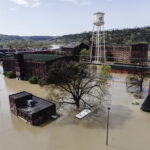The Federal Emergency Management Agency reported its 2020 traditional reinsurance placement for the National Flood Insurance Program, a transaction in which 27 private reinsurers assumed $1.33 billion of NFIP’s financial risk.
This annual reinsurance agreement is effective from January 1, 2020 to January 1, 2021. FEMA now has transferred a total of $2.13 billion of the NFIP’s flood risk for the 2020 hurricane season to the private sector.
The 2020 placement of reinsurance covers portions of NFIP losses above $4 billion arising from a single flood event. FEMA paid a total premium of $205 million for the coverage.
The 2020 traditional reinsurance program mirrors the 2019 reinsurance program that FEMA negotiated with 28 reinsurers. FEMA paid a total premium of $186 million for the 2019 coverage.
If a qualifying catastrophic flood event occurs, the reinsurance companies cover a portion of the NFIP’s losses, contributing to FEMA’s ability to pay claims before it needs to borrow from the U.S. Treasury.
The agreement is structured to cover:
- 10.25 percent of losses between $4 billion and $6 billion,
- 34.68 percent of losses between $6 billion and $8 billion, and
- 21.80 percent of losses between $8 billion and $10 billion.
Combined with the $500 million August 2018 capital markets reinsurance placement and the $300 million April 2019 capital markets reinsurance placement, FEMA has transferred $2.13 billion of the NFIP’s flood risk for 2020 to the private sector.
If a named storm event is large enough to trigger all reinsurance agreements (i.e., a named storm event where NFIP claims exceed $6 billion), FEMA would receive qualifying payments under all reinsurance agreements. Should a named storm event result in NFIP claims exceeding $10 billion, FEMA would receive the full $2.13 billion of reinsurance coverage from the private markets.
“It takes the whole community to prepare for disasters, and that includes participation from the private sector. Through reinsurance, FEMA partners with private markets to build a pillar that supports a sound financial framework for the NFIP by a meaningful transfer of flood risk,” said David Maurstad, deputy associate administrator of the NFIP.
Historically, the NFIP was limited to using flood insurance premiums, available surplus, borrowing capacity from the U.S. Treasury, and in some cases, direct appropriations from Congress to pay flood claims.
FEMA contracted with reinsurance broker Guy Carpenter to provide broker services to assist in the reinsurance placement. FEMA also contracted with Aon for financial advisory services for the placement.
This is the fourth year in a row that FEMA has procured private reinsurance.
FEMA received authority to secure reinsurance through the Biggert-Waters Flood Insurance Reform Act of 2012 and the Homeowner Flood Insurance Affordability Act of 2014.
*This story ran previously in our sister publication Insurance Journal.





















 Flood Cleanup Continues at Kentucky Distillery
Flood Cleanup Continues at Kentucky Distillery  Roof Repair and Replacement Costs Up Nearly 30% Since 2022: Verisk
Roof Repair and Replacement Costs Up Nearly 30% Since 2022: Verisk  U.S. P/C Industry Combined Ratio Headed Back Up to 100: S&P Ratings
U.S. P/C Industry Combined Ratio Headed Back Up to 100: S&P Ratings  Beyond Automation: How GenAI Informs Next Best Action in P/C Insurance Claims and Underwriting
Beyond Automation: How GenAI Informs Next Best Action in P/C Insurance Claims and Underwriting 








